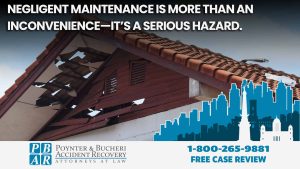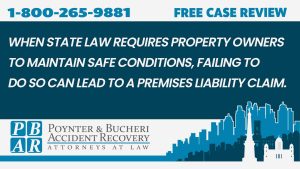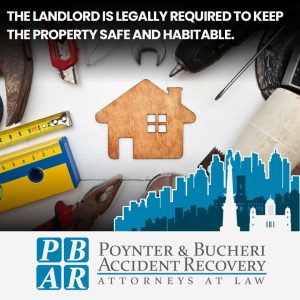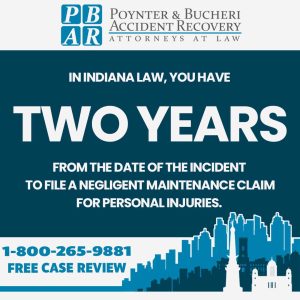
Negligent maintenance is more than an inconvenience—it’s a serious hazard. Under Indianapolis premises liability law, property owners and managers have a legal obligation to adequately maintain safe conditions for tenants, customers, and visitors. Failing to address hazards such as broken stairs, faulty wiring, or poor lighting can result in serious personal injuries or even wrongful death. In Indianapolis, aging buildings and neglect only make these risks more common, putting more people in harm’s way.
At Poynter & Bucheri, our premises liability attorneys specialize in Indianapolis premises liability law, holding negligent property owners accountable and fighting for the maximum compensation you deserve. If you suffered a personal injury on someone else’s property due to dangerous property conditions, don’t wait—contact our law firm today for a free consultation: 800-265-9881.
What Are the Different Types of Negligent Maintenance?

Inadequate property maintenance poses serious safety risks. Property owners and property managers must keep their premises safe, and neglecting proper maintenance can lead to accidents, personal injuries, and even wrongful death.
A premises liability case ensures the liable party is held responsible for the injuries sustained by dangerous conditions. Common examples of inadequate maintenance include:
- Broken or Poor Lighting
- Loose or Broken Handrails
- Cracked or Uneven Floors and Walkways
- Cluttered or Obstructed Walkways
- Unsafe Pool Areas
- Failure to Address Weather-Related Hazards
- Poor Maintenance of Electrical and Plumbing Systems
- Unsafe Balconies, Decks, and Porches
When state law requires property owners to maintain safe conditions, failing to do so can lead to a premises liability claim. If you’ve been a victim of Indianapolis premises negligence, contact a Poynter & Bucheri liability attorney today for a free initial consultation.
How Improperly Maintained Property Causes Slip and Fall Accidents
Under Indianapolis premises liability law, Indiana property owners must keep their premises free of trip hazards. Below are common slip-and-fall incidents a liability attorney can handle and common injuries resulting from poor upkeep.
Types of Slip-and-Fall Accidents
- Tripping accidents: Occur when someone stumbles over an uneven surface, loose carpet, or an obstruction
- Slipping accidents: Happen when a person loses footing due to wet, icy, or polished surfaces
- Step and fall accidents: Result from missing steps, broken stairs, or sudden changes in flooring height
- Stumbling accidents: Occur when someone loses balance due to unstable surfaces or handrails
Typical Injuries From Slip-and-Fall Accidents
- Bruises, cuts, and abrasions
- Sprained or broken ankles, wrists, and fingers
- Fractures, particularly in hips, arms, and legs
- Concussions or traumatic brain injuries (TBI) from hitting the ground or an object
- Spinal cord injuries, which may lead to long-term mobility issues
- Soft tissue injuries, including ligament and muscle damage
- Internal injuries from forceful impact
If you experienced one of these Indiana slip injuries on another party’s property, contact an Indianapolis premises liability lawyer to recover compensation.
What To Do After a Negligence Maintenance Injury

If you’ve suffered a personal injury due to maintenance issues on someone else’s property, taking the proper steps will help protect your legal rights and strengthen your claim. Documentation and legal action can ensure the property owner is held liable for their negligence. Here’s what to do:
- Seek Medical Attention – Your health is the top priority. Even if injuries seem minor, see a doctor to assess any hidden or delayed injuries.
- Report the Incident – Notify the property owner, manager, or landlord about the accident. Request a written incident report and keep a copy for your records.
- Document the Scene – Take photos and videos of the hazards that caused your injury, such as broken flooring, poor lighting, or missing handrails. Capture the surrounding area and any visible injuries.
- Collect Witness Information – Get names and contact details if anyone saw the accident. Their statements can help support your premises liability claim.
- Keep Medical Records and Expenses – Maintain copies of doctor visits, treatment plans, prescriptions, and receipts for any medical costs related to your injury.
- Avoid Giving Statements to Insurance Companies – Insurance adjusters may try to minimize your claim. Refrain from making recorded statements or signing anything without consulting a lawyer.
- Consult a Negligent Maintenance Lawyer – An experienced liability attorney can assess your case, negotiate with insurance companies, and help you seek the maximum compensation for your personal injury.
Taking these steps can help ensure the responsible party is held accountable for premises liability.
How Proper Signage Can Help Mitigate Injuries

Clear signage helps prevent injuries by warning people of hazards and guiding them safely through the premises. Without proper signs, slips, trips, and falls are more likely. Well-placed, easy-to-read signs reduce risks and help protect customers in several ways:
- Alerting People to Hazards – Signs warning of wet floors, uneven surfaces, or construction zones allow individuals to proceed cautiously or avoid dangerous conditions altogether.
- Preventing Slip-and-Fall Accidents – Marking areas with slick surfaces, such as freshly mopped floors or icy walkways, reduces the likelihood of fall injuries.
- Guiding Safe Movement – Directional signs in stairwells, parking lots, and hallways ensure people know where to walk and avoid potential obstacles.
- Indicating Restricted or Unsafe Areas – Signs that warn against entry to hazardous zones, such as areas with electrical work or unstable flooring, help prevent unnecessary exposure to danger.
- Enhancing Legal Protection – Property owners who use proper signage demonstrate a reasonable effort to maintain safety, which can reduce their premises liability in the event of an accident.
Effective signage should be placed in visible locations, use clear language and symbols, and be maintained to ensure readability. Property owners can significantly reduce their chances of a premises liability case by taking this simple precaution.
The Four Factors Needed To Establish Negligently Maintained Property

Four key factors must be shown to prove premises liability in a negligent maintenance claim. These factors demonstrate that the property owner failed to maintain safe premises, harming the injured party.
- Duty of Care – The property owner or manager was legally responsible for maintaining a safe environment for visitors, tenants, or employees. This duty applies to private and public property, including rental properties, businesses, private residences, and workplaces.
- Breach of Duty – The property owner failed to uphold their duty by allowing hazardous conditions to exist. This could include failing to fix broken flooring, neglecting to remove ice from walkways, or not repairing faulty handrails.
- Causation – The hazardous condition directly caused the injury. The injured person must show that their accident directly resulted from the property owner’s negligence, not unrelated factors.
- Damages – The injury caused real harm, like medical bills, lost wages, or even permanent disability. Pain and suffering and other non-economic damages may also be included in a claim. Keeping records—such as medical reports, witness statements, and photos of the hazard—can help prove your case.
Proving all four factors is essential to the legal process. If you’ve been injured due to unsafe conditions on another’s property, contact the best Indianapolis premises liability lawyers at Poynter & Bucheri for a free consultation.
How To Prove Your Landlord Was At Fault for Negligent Maintenance

To hold your landlord responsible for negligent maintenance, you must prove the following:
Duty To Maintain the Property – The landlord is legally required to keep the property safe and habitable. This includes fixing structural issues, maintaining common areas, and addressing known hazards.
Knowledge of the Hazard – You must show that the landlord knew or should have known about the dangerous condition. Maintenance requests, emails, or tenant complaints can serve as evidence.
Failure To Fix the Issue – The landlord ignored or delayed necessary repairs, such as broken flooring, faulty wiring, or poor lighting, creating a dangerous property condition.
Direct Cause of Injury – The hazardous condition led to your injury. Medical records, photos, witness statements, and incident reports can help prove this.
Resulting Damages – Your injury caused real harm, such as medical fees, lost income, or pain and suffering. Keeping documentation strengthens your case.
By gathering strong evidence and records, tenants can build a solid case against a negligent landlord and seek the compensation they deserve.
Tenant Responsibilities in Avoiding Injury
While landlords must maintain the property, tenants also have a role in staying safe. This includes:
- Reporting Hazards Promptly – If you notice leaks, broken stairs, or electrical issues, inform your landlord in writing and keep a record of your request.
- Following Safety Guidelines – Avoid misusing appliances, overloading electrical outlets, or blocking emergency exits.
- Keeping Living Spaces Clear – Prevent personal clutter that could contribute to trips and falls.
- Allowing Repairs and Inspections – If a landlord schedules maintenance, cooperate to address hazards.
By following these steps, tenants can help prevent injuries and strengthen their case if negligence leads to an accident. If a landlord ignores repeated complaints, contacting an Indianapolis premises liability lawyer may be necessary.
How Long You Have To File a Negligent Maintenance Claim in Indiana

In Indiana law, you have two years from the date of the incident to file a negligent maintenance claim for personal injuries, as stated in Ind. Code § 34-11-2-4(a). A different statute of limitations may apply if your claim involves property damage rather than an injury. Consulting an experienced Indianapolis premises liability lawyer can help you meet the correct legal deadline.
Two years may seem like plenty of time, but acting quickly is essential. Medical expenses and lost income can add financial stress, and waiting too long can make collecting evidence and witness statements harder.
Hiring an experienced Indianapolis premises liability lawyer early ensures your claim is filed correctly and on time, giving you the best chance of getting the compensation you deserve.
Contact a Negligent Maintenance Lawyer Today
Don’t wait to seek justice if you’ve been injured due to unsafe property conditions. At Poynter & Bucheri, we offer compassionate legal representation backed by our combined legal experience in premises liability law. Our team is dedicated to holding negligent property owners accountable and helping you recover the compensation you deserve under the law. Call our law firm today at 800-265-9881 or click here to schedule a free initial consultation. Let us fight for your rights and provide the strong legal support you need.
